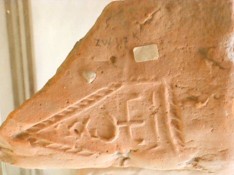Nigrum Pullum (Zwammerdam)
Q3341443Nigrum Pullum: Roman limes fort in Germania Inferior, modern Zwammerdam in The Netherlands.

The small fort at Nigrum pullum ('black chicken' or 'black soil') controlled the confluence of the little river Meije and the Rhine, the frontier river of the Roman empire. The military settlement was founded after 47, when the Roman general Gnaeus Domitius Corbulo reorganized the frontier zone. The wooden barracks were destroyed during the Batavian Revolt (69). They were not immediately reconstructed: the second building phase can be dated after 80.
It was again rebuilt, this time from natural stones and bricks, after 175, a building phase that may probably be connected to the presence of Didius Julianus, a governor who is known to have built other fortifications (Maldegem). Because we know that soldiers of the legion XXX Ulpia Victrix from Castra Vetera (modern Xanten) made the roof tiles, we can assume that they were also responsible for the reconstruction of the fort as a whole. Hundred years later, Nigrum pullum was burned down and -as far as we know- never used again.

The remains of this ancient military settlement were discovered and excavated in 1971. The foundations of the southern gate and headquarters can still be seen at the premises of The Hooge Burgh, which is to the southwest of the main road.
To the northeast of the castle was a quay along the Rhine, where archaeologists have discovered no less than six ships, including three large prams (20 - 34 meters long). It could be established that the wood from which they had been made was cut in the region of the Middle Rhine, which suggests that the merchants had made a long voyage. It is possible that they carried the stones from which the fort was rebuilt.
One of these ships, the pram known as Zwammerdam 6, appears to have been the sister ship of a galley-freighter found 15 kilometers upstream, the Woerden 7, which was discovered in the river port of ancient Laurium. It also resembles the Mainz 6.
The ships, which caused a sensation, are no longer there (they used to be in a museum at Ketelhaven), although a reconstruction of one pram can be seen in the Archeon Museum park.
 Zwammerdam 2 = Mainz 3, model |
 Remains of the Zwammerdam 3 |
 Remains of the Zwammerdam 3. |
 Zwammerdam 3, model. |
 Zwammerdam 5, model. |
 Reconstruction of the Zwammerdam 6 |
 Zwammerdam 6, model. |